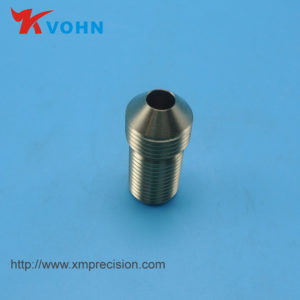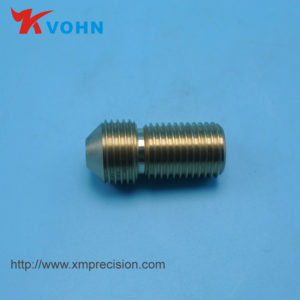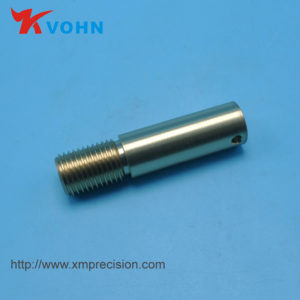Q1. Classification of contact current. CNC parts online
Answer For the electronic products with different structures, the measurement of contact current also has different requirements, but in summary, the contact current can be divided into ground contact current Ground Leakage Current, surface to ground contact current Surface to Line Leakage Current and surface contact There are three types of current Surface to Surface Leakage Current tests. CNC parts online
Q2. Why do you want to do a contact current test?
Answer Metal parts or enclosures accessible to electronic products of Class I equipment should also have good grounding wiring as a protection against electric shock other than basic insulation. However, we often encounter some users who use Class I devices as Class II devices at will, or that the power input terminals of Class I devices are directly removed from the ground (GND). This poses a certain safety hazard. Even so, as a manufacturer, it is obligatory to avoid the danger that this situation poses to the user. This is why the contact current test is done.
Q3. Why is there no standard for the leakage current setting of the withstand voltage test?
Answer There is no standard in the AC withstand voltage test due to the different types of materials to be tested, and there are stray capacitances in the measured object and different test voltages. CNC parts online
Q4. How to determine the test voltage?
The best way to determine the test voltage is to set it according to the specifications required for the test. In general, we will use 1000 times the working voltage plus 1000V as the test voltage setting. For example, if a product’s operating voltage is 115VAC, we will use 2 x 115 + 1000 = 1230 Volt as the test voltage. Of course, the test voltage will also be set differently depending on the level of the insulation layer.
Q5. What is the difference between Dielectric Voltage Withstand Testing, High Potential Testing, and Hipot Testing?
A These three nouns all have the same meaning, but are often used interchangeably in the test industry. CNC parts online
Q6. What is the insulation resistance (IR) test?
The insulation resistance test and the withstand voltage test are very similar. Apply a DC voltage of up to 1000V to the two points that need to be tested. The IR test usually gives the resistance value in megaohms, not the Pass / Fail value of the withstand voltage test. Typically, the test voltage is 500V DC and the value of the insulation resistance (IR) must not be less than a few megaohms. The insulation resistance test is a non-destructive test, and it can detect whether the insulation is good. In some specifications, the insulation resistance test is performed first and then the withstand voltage test is performed. When the insulation resistance test cannot pass, the withstand voltage test cannot pass. CNC parts online
Q7. What is the Ground Bond test?
A ground connection test, known as the Ground Continuity test, measures the impedance between the DUT’s frame and the ground post. The ground connection test determines if the DUT’s protection circuit is capable of handling the fault current if the product is broken. The ground connection tester will generate a DC current or AC rms current (CSA required to measure 40A) through the ground circuit up to 30A to determine the impedance of the ground circuit, which is typically below 0.1 ohms.
Q8. What is the difference between the withstand voltage test and the insulation resistance test?
Answer The IR test is a qualitative test that gives an indication of the relative quality of the insulation system. It is usually tested with a DC voltage of 500V or 1000V and the result is measured with a megaohm resistor. The withstand voltage test also applies a high voltage to the DUT, but the applied voltage is higher than the IR test. It can be done at AC or DC voltage. The results were measured in milliamperes or microamps. In some specifications, the IR test is performed first, followed by the withstand voltage test. If a DUT cannot pass the IR test, the DUT cannot pass the withstand voltage test at a higher voltage. CNC parts online
Q9. Why does the ground impedance test have an open circuit voltage limit? Why is it recommended to use alternating current (AC) current?
The purpose of the grounding impedance test is to ensure that the protective earthing wire can withstand the flow of fault currents to ensure the safety of the user when an abnormal condition occurs in the equipment. The safety standard test voltage requires that the maximum open circuit voltage should not exceed the 12V limit, that is, based on the user’s safety considerations, the risk of electric shock to the operator can be reduced once the test object has a test failure. The general standard requires that the grounding resistance be less than 0.1 ohm. It is recommended to use the AC current test with a frequency of 50 Hz or 60 Hz to meet the actual working environment of the product.
Q10. What is the difference between the withstand voltage test and the leakage current measured by the power leakage test?
There are some differences between the withstand voltage test and the power leakage test, but in general, these differences can be summarized as follows. The withstand voltage test uses high voltage to insulate the product to determine if the insulation strength of the product is sufficient to prevent excessive leakage current. The leakage current test measures the amount of leakage current flowing through the product during normal and single power failure conditions. CNC parts online
Q11. How to determine the discharge time of a capacitive load during DC withstand voltage test?
The difference in discharge time depends on the capacitance of the test object and the discharge circuit of the withstand voltage tester. The larger the capacitance, the longer the discharge time required. CNC parts online
Q12. What is the withstand voltage test?
A pressure test or high voltage test (HIPOT test) is a kind of 100 used to verify the quality and electrical safety characteristics of products (such as JSI, CSA, BSI, UL, IEC, TUV and other international safety agencies). % of the line testing is also the most well known and often performed line safety test. The HIPOT test is a non-destructive test that determines that electronically insulating materials are resistant to transient high voltages and is a high voltage test that is suitable for all equipment to ensure that the insulation is adequate. Another reason for conducting a HIPOT test is that it can detect possible leakage distances and gaps that may be caused during the manufacturing process. CNC parts online
Q13. Why do you want to do a withstand voltage test?
A Normally, the voltage waveform in the power system is a sine wave. During the operation of the power system due to lightning strikes, operations, faults or improper coordination of electrical equipment parameters, etc., the voltage of some parts of the system suddenly rises, greatly exceeding its rated voltage, which is the overvoltage. Overvoltage can be divided into two categories according to the reasons for its occurrence. One is overvoltage caused by direct lightning strike or lightning induction, which is called external overvoltage. The magnitude of the lightning impulse current and the surge voltage is large, and the duration is short and extremely destructive. However, due to the shielded protection of 3-10kV and below in urban and general industrial enterprises, the probability of direct lightning strikes is small and safe because of the shield protection of the factory buildings or tall buildings. Moreover, the civil appliances discussed here are not within the above range and will not be discussed further. The other type is caused by energy conversion or parameter changes inside the power system, such as cutting the no-load line, cutting off the no-load transformer, single-phase arc grounding in the system, etc., called internal overvoltage. Internal overvoltage is the main basis for determining the normal insulation level of various electrical equipment in the power system. That is to say, the design of the insulation structure of the product should not only consider the rated voltage but also the internal overvoltage of the product use environment. The withstand voltage test is to test whether the insulation structure of the product can withstand the internal overvoltage of the power system. CNC parts online
Q14. What are the advantages of AC withstand voltage test?
A: Usually the AC withstand voltage test is easier to accept from the safety mechanism than the DC withstand voltage test. The main reason is that most of the tested items will work below the AC voltage, and the AC withstand voltage test provides the advantage of alternating the two polarities to apply pressure to the insulation, closer to the pressure that the product will encounter in actual use. Since the AC test does not charge the capacitive load, the current reading remains the same from the time the voltage is applied until the end of the test. Therefore, since there is no stabilization problem required to monitor the current reading, there is no need to gradually increase the voltage. This means that unless the product under test senses a sudden applied voltage, the operator can immediately apply the full voltage and read the current without waiting. Since the AC voltage does not charge the load, there is no need to discharge the device under test after the test. CNC parts online
Q15. What are the disadvantages of AC withstand voltage test?
A When testing a capacitive load, the total current consists of reactive current and leakage current. When the amount of reactive current is much larger than the actual leakage current, it may be difficult to detect a product with excessive leakage current. When testing large capacitive loads, the total current required is much larger than the leakage current itself. This can be a greater danger because the operator is facing more current. CNC parts online
Question 16. The difference between AC withstand voltage test and DC withstand voltage test
Answer There are two types of withstand voltage tests: AC withstand voltage test and DC withstand voltage test. Due to the nature of the insulating material, the breakdown mechanism of the AC and DC voltages is different. Most insulation materials and systems contain a range of different media. When an AC test voltage is applied to it, the voltage will be distributed in proportion to the ratio of the dielectric constant and size of the material. The DC voltage distributes the voltage only in proportion to the resistance of the material. In fact, the breakdown of the insulation structure is often caused by electrical breakdown, thermal breakdown, discharge, etc., which are difficult to separate. The AC voltage increases the likelihood of thermal breakdown than the DC voltage. Therefore, we believe that the AC withstand voltage test is more stringent than the DC withstand voltage test. In actual operation, when performing the withstand voltage test, if the DC voltage test is to be used, the test voltage requirement is higher than the test voltage of the AC power frequency. The test voltage for a typical DC withstand voltage test is obtained by multiplying the effective value of the AC test voltage by a constant K. Through comparison test, we have the following results: wire and cable products, constant K is 3; aviation industry, constant K is 1.6 to 1.7; CSA is generally used for civilian products 1.414. CNC parts online
Q17. How do I determine the test voltage used in the withstand voltage test?
A The test voltage that determines the withstand voltage test depends on the market in which your product is to be placed. You must comply with the safety standards or regulations of the country’s import control regulations. The test voltage and test time of the withstand voltage test are specified in the safety standard. The ideal situation is to ask your customers to give you relevant test requirements. The test voltage for the general withstand voltage test is as follows: the operating voltage is between 42V and 1000V, and the test voltage is twice the working voltage plus 1000V. This test voltage is applied for 1 minute. For example, for a product operating at 230V, the test voltage is 1460V. If the time to apply the voltage is reduced, the test voltage must be increased. CNC parts online
Q18. What is the capacity of the withstand voltage test, and how is it calculated?
A The capacity of the withstand voltage tester is its power output. The withstand voltage tester capacity is determined by the maximum output current x the maximum output voltage. For example: 5000Vx100mA=500VA
Q19. Why is the leakage current value measured by the AC withstand voltage test and the DC withstand voltage test different?
Answer The stray capacitance of the measured object is the main reason for the difference between the measured values of the AC and DC withstand voltage test. These stray capacitances may not be fully charged when tested with AC, and a continuous current will flow through these stray capacitances. With the DC test, once the stray capacitance on the object is filled, the rest is the actual leakage current of the measured object, so the leakage current value measured by the AC withstand voltage test and the DC withstand voltage test will be different. CNC parts online
Question 20. What is the leakage current of the withstand voltage test?
Answer The insulator is not electrically conductive, but virtually no insulating material is absolutely non-conductive. Any kind of insulating material, when a voltage is applied across it, there will always be a certain current. The active component of this current is called the leakage current, and this phenomenon is also called the leakage of the insulator. For the testing of electrical appliances, the leakage current refers to the current between the metal parts with electrical insulation in the electrical insulation, or between the live parts and the grounding parts, and the surrounding medium or insulating surface. For leakage current. According to the U.S. UL standard, the leakage current is a current including a capacitive coupling current that can be conducted from a part of the household appliance. The leakage current consists of two parts, one is the conduction current I1 through the insulation resistance; the other is the displacement current I2 through the distributed capacitance, the latter’s capacitive reactance is XC=1/2pfc is inversely proportional to the power supply frequency, and the distributed capacitance current increases with frequency. And increase, so the leakage current increases as the power supply frequency increases. For example, using a thyristor, its harmonic components increase the leakage current.
Q. What are the advantages of the DC withstand voltage test? CNC parts online
A When the device under test (DUT) is fully charged, only the true leakage current flows through it. This allows the DC withstand tester to clearly show the true leakage current of the product under test. Since the charging current is short-lived, the power requirements of the DC withstand tester can usually be much smaller than the power requirements of the AC withstand tester used to test the same product.
Q22. What are the disadvantages of the DC withstand voltage tester?
Answer Since the DC withstand voltage test does charge the DUT, in order to eliminate the risk of electric shock to the operator handling the DUT after the withstand voltage test, the DUT must be given after the test. Discharge. The DC test charges the capacitor. If the DUT actually uses AC power, the DC method does not simulate the actual situation. CNC parts online
Q23. What is the difference between the leakage current of the withstand voltage test and the power supply leakage current (contact current)?
The voltage withstand test is to detect the leakage current flowing through the insulation system of the object to be tested, and apply a voltage higher than the working voltage to the insulation system; and the power leakage current (contact current) is under the normal operation of the object to be tested. One of the most unfavorable conditions (voltage, frequency) measures the leakage current against the measured object. Simply put, the leakage current of the withstand voltage test is the leakage current measured under the no-operation power supply, and the power supply leakage current (contact current) is the leakage current measured under normal operation. CNC parts online
CNC Machining Service & CNC Machining parts

oem metal fabrication

metal component manufacturers

oem metal

metal parts manufacturer china

metal parts china

cnc machining china factory

tungsten products
